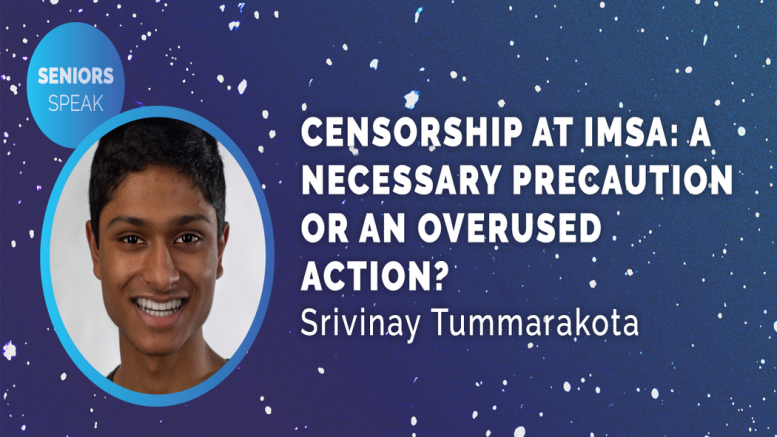One of the sections included in the annual Senior Edition is a series of essays titled Seniors Speak. These works are written and submitted to The Acronym by members of the graduating class, allowing them to reflect on their experiences, share advice, and advocate for change. The writer of this piece is Srivinay Tummarakota (Rice University ’23), who lived in 1505C during his senior year. He served as Student Council president after being Junior at Large and Sophomore at Large.
The Merriam-Webster dictionary defines the verb censor as “to examine in order to suppress or delete anything considered objectionable.” With this definition in mind, I want to tackle an issue that has been voiced multiple times from students: the issue of censorship.
By analyzing the following cases of alleged censorship, I aim to provide the IMSA community with a better understanding of to what degree censorship manifests itself at IMSA and what the consequences of such censorship would entail.
Before I begin, however, I’d like to note that a baseline level of censorship is necessary for academic institutions. There are obvious reasons why sexually suggestive content and promotion of illicit substances are censored at IMSA. The cases that follow are meant to address concerns raised by students and provide an objective understanding of whether censorship was consistently and appropriately used.
“A Tale of Three High Schools: The Data on Diversity”
On December 11th, 2018, The Acronym emailed a set of articles out to students, one of which was the aforementioned article written by junior Grace Yue. In the article, Yue discusses the differences between admissions policies of IMSA, Thomas Jefferson High School for Science and Technology (TJHSST), and Stuyvesant High School (SHS) and displays their racial breakdown. Yue’s final graph displayed the racial breakdown of the students in the 2016 IMSA Applicant Pool if students were admitted purely based on highest SAT score.
A little less than two days later, the article was taken down from The Acronym’s website on the grounds that Yue did not consult the Office of Institutional Research and IMSA Admissions before publishing the article. Yue was also informed that her article resulted in hurt feelings from several students, staff, and parents alike. Katie Berger, Executive Director of Student Affairs, offered Yue the opportunity to revise the article. However, Yue claims that she felt discouraged from revising the article given what she believed to be strong resistance to its publication that could result in burning institutional bridges between The Acronym and several other IMSA departments. Thus, Yue elected not to rewrite the article.
Regarding the procedural errors in the article’s publication, Dr. Amber Pareja, Executive Director of the Office of Institutional Research, said the articles involving IMSA data must be reviewed by an individual trained in data analysis prior to publication. This individual could be a member of faculty, the Office of Institutional Research, or in Yue’s situation, Kelly Lofgren, Director of IMSA Admissions. The rationale is because presentation of data involves some level of interpretation, it is important to have a secondary reviewer to ensure that this interpretation is accurate and considers contextual factors.
However, I asked why previous data journalism articles published by The Acronym never underwent review by a data analysis professional. To which Dr. Pareja responded by saying that the Executive Director/Director of OIR position had been vacant for two years prior to her arrival, and she has served as OIR Director for roughly 2.5 years. As a result, OIR is still working on building relationships with various groups on campus to ensure that IMSA data is properly represented. Pareja clarified that had she known about the articles prior to publication, she would have requested that they be reviewed by an individual trained in data analysis.
Kelly Lofgren, Director of IMSA Admissions, added that Yue’s article incorrectly conflated SAT Score with Merit, an interpretation of the data that could lead readers astray. In Lofgren’s opinion, Yue’s article would’ve been better received had it been labeled as in opinions piece rather than news piece because of this conflation. Additionally, Lofgren said that the assertion that SAT Score is a measurement of merit is inaccurate as she has reviewed applicants who have near perfect SAT scores but poor classroom behavior – sleeping in class, not participating – which is an undesirable quality of applicants. Lofgren also brought up the fact that the SAT measures how much knowledge a student possesses, not their critical thinking ability or passion for STEM. Another question raised about the article was whether admissions representatives from SHS and TJHSST were ever contacted to explain their admissions process and demographics for use in the article.
Were Yue’s article to have been taken down solely on the basis that it resulted in hurt feelings from members of the IMSA community, I would be in vehement disagreement with the decision mainly because hurt feelings are not an appropriate justification for censorship. To prove this point, take the example of IMSA requiring students to view a documentary which makes the claim that “All white people are racist”. Although students are given the opportunity to discuss and debate this idea, requiring the documentary’s viewing could make white students feel uncomfortable. Yet, this documentary is not only not censored, but it is mandatory for all students to view, a sign that IMSA’s administrators believe hurt feelings should not prevent students from having critical conversations about social issues.
Ultimately, in my opinion, the conflation of SAT Score with “Merit” justifies Lofgren, Pareja, and Berger’s request for revision. This is because the article perpetuates the opinion that merit is accurately measured by SAT scores while it is labeled as an informative news piece.
The 06 Clash T-Shirt Design
This Clash Season, members of 1506 created a t-shirt design with a woman’s face covering the front. When receiving approval for their design, the students were asked to depict the woman as a person of color to be more inclusive. Consequently, the designers modified the woman’s face to be Asian. After RC’s consulted members of administration, this design was replaced on the grounds that depicting a woman of a particular race would necessarily exclude certain members of the hall, and eliminating the face altogether would be the most inclusive design.
However, what was especially confusing was that prior designs showing a racially ambiguous (gray hair and pink skin) woman were rejected as well. The Asian face was censored from the design on the grounds that depicting a woman of a particular race was inherently exclusive, yet the reason why the racially ambiguous design was rejected was because it explicitly avoided depicting a certain race. The T-Shirt Design saga is an example of how a well-meaning impulse toward social justice resulted in censorship of artistic expression. The frustrating part of this situation is that students made repeated attempts to satisfy the recommendations made by RC’s involved, but each time were rebuffed by a set of shifting and contradictory stipulations.
Wearing Clothing in Support of Donald Trump
During this school year, a student wore a flag in support of Donald Trump in the main building. Although this student did not receive complaints during the day, the student claimed they were notified by their RC that pro-Trump symbols could be seen as hateful. The student also alleged that security notified the RC of students walking around with a Trump flag and that the RC notified their parents of the messaging of Trump paraphernalia.
To better understand the situation, I reached out to the RC involved. The RC stated that they did not recall the specific situation mentioned, but did say that fashion choices are a form of speech and students should be aware of the messages they are representing.
While I understand that students should feel welcome on campus, RC’s should not be raising concern over the political statements students express via fashion choices. It is hypocritical for RC’s to warn students who don MAGA hats about the messages they are representing only to permit students to hoist Obama posters at Clash Pep Rally in front of the entire student body. Both Obama and Trump have been the President of the United States. Why raise concern over symbols of one President but not the other? In this situation, it is clear to me that the threat of censorship was used on political grounds.
Leadership Education and Development
In the 2017-2018 school year, a student sought to base their LEAD project around the conservative idea of revising poverty brackets to encourage low-income families to rise out of poverty. The student alleged that, when the facilitators heard the idea, they responded claiming the student’s idea would be “torn up” by the judges and should not be pursued.
When hearing about this incident, Priyanka Sarangabany, LEAD Co-Coordinator, stated, “Facilitators are told not to veer off from speaking about conservative topics, so it is especially concerning that this happened last year”. Assistant Director of Student Life Andrea Stuiber echoed this sentiment saying that, had this incident occurred, using the phrase “torn up” is not an appropriate method to provide feedback for students. Stuiber also mentioned that she is very keen on ensuring that facilitators are aware of their political biases, so that these situations can be better handled.
Hall Movie
The beginning of 1504’s movie displayed a picture falling out of the ceiling which was subsequently picked up by the movie’s protagonist. This scene was replaced because it could be associated with the storage of illicit substances within ceiling tiles. Although they disputed the logic behind the connection to drugs, 1504’s primary concern surrounded the inconsistent application of censorship of references to drugs.
In 1501’s Hall Movie, for example, the main character enters a nightclub, receives a drink from a man she does not know, wakes up in a new area, and sees strange visions of lights, all of which could point to the use of “hard” drugs. When I brought this up to a member of Director of Campus Activities, Amy Woods, she said that, at the time she reviewed the movies, she did not see the connection, but had she done so, parts of the movie would have likely needed revision. Woods touched on the toughest issue regarding censorship: censorship is necessary, but the level to which it should be used is almost entirely subjective.
1507 also raised concerns of the replacement of scenes in their movie, particularly one involving a root beer can. In the movie, 1507’s original movie involved a scene with “Torres-approved, non-alcoholic root beer”.
Although the root beer was explicitly stated as “non-alcoholic”, Woods said that it would be easy to screenshot a photo from the scene with Dr. Torres’ face plastered on what looked similar to a beer bottle. Thus, despite the audio being clear about the content of the bottle, the visuals could’ve easily been taken out of context.
The instances of the alleged Hall Movie censorship reveal that deeming content “objectionable” is inherently a subjective task, but ultimately, a task that must be done for the preservation of activities such as Clash. Without sufficient review, movies with inappropriate content could be used to justify the elimination of Hall Movie entirely.
At the end of the day, however, I believe that censorship was used inconsistently given what could easily be viewed as references to hard drugs in 1501’s movie. If the concern is people outside of the IMSA community taking these videos out of context, frankly, the photo falling from the ceiling has a much lower probability of being manipulated than the storyline of 1501’s movie.
Hall Decorations
This year, 1502’s theme of Camelo2 surrounded the tales of the Knights of Arthur and their adventures in Camelot. As a result, they opted to use the crown as their theme’s primary symbol along with the sword as a prop. Many of Camelo2’s events included the use of the sword in non-violent manners (hall movie, talent show, and hall decorations), leaving members of 1504 irritated by the rejection of the decorations they had sought to make at the beginning of the year.
Before the start of the school year, the RSL’s in 1504 wanted to make hall decorations for the theme of Warrior4 which involved the depiction of swords and other weapons. Assistant Director of Student Life Andrea Stuiber stated that 1504 was not permitted to do so because the student handbook clearly states:
“Students shall not possess any weapons or look-alike weapons on campus. This includes, but is not limited to, toy guns (including water guns, Nerf guns), swords, nunchucks, etc. If students need props for educational purposes (i.e. class assignments, plays, video projects), said props will be stored in the hall office and taken home by the parents/guardians after the assignment is completed.”
Because Clash is a temporary event and the decorations are not used year round, 1502 was permitted to use weapons in a non-violent manner. However, while look-alike weapons are not allowed, this rule does not actually cover the depiction of said weapons. In my mind, a picture of a sword is not equivalent to a physical look-alike weapon and does not constitute a violation of this rule.
Stuiber also said that the violent connotation of Warrior4 would not be welcoming to the incoming sophomores in the hall as the handbook states:
“Students who choose to attend the Academy are committed to developing their personal and social skills along with their academic talents. The residence halls are places where living and learning meet. There, students will encounter new and different people, encounter new ideas and differing values, and test their self-discipline. Students will find the halls are places where all elements of the IMSA community fuse.”
However, the violent connotation arises from the context in which weapons are depicted and not from their mere presence. Camelo2 should be allowed to use swords because the context is a children’s fantasy story. And as the handbook correctly points out, courses such as “Conflict in World History” and “Modern Genocide and Mass Violence” should exist because they analyze violence in an educational context. I believe that the censorship of Warrior4 is an overstep that reflects an unwillingness to look at artistic expression in context, which in this case, is the discipline and honor embodied by warriors. Moreover, discipline and the notion of warriorhood across different cultures fits well with the “self-discipline” and “differing values” that the previous passage praises.
Conclusions
To reiterate my earlier point, I firmly believe that censorship is necessary, but, as some – but not all – of the previous cases have shown, censorship has been applied inconsistently, sometimes on seemingly political lines. If parental outcry results in censoring certain content, the same standard should be held consistently. And if certain halls are allowed to produce certain content, other halls should be allowed to as well.
But ultimately, determining how to apply censorship consistently requires a clear definition of “objectionable content.” In a residential high school where students should feel safe and welcomed by their peers, this is a tough balance to maintain.
For apolitical issues, “appropriate” levels of censorship can only be analyzed on a case-by-case basis as I’ve done in this article. There are enormous amounts of subjectivity involved when determining what constitutes “appropriate” censorship.
For political issues, however, increasing dialogue is far more effective than restraining it. Censorship does not change the reasons why people support a given belief; it merely prevents them from stating those beliefs in public. Censorship inevitably results in further reinforcement and radicalization of political echo chambers. And as we navigate censorship in the context of political issues, we should keep in mind one of IMSA’s core goals: “Diverse perspectives enrich understanding and inspire discovery and creativity.”
It is not censorship of our ideas, but rather their diversity that allows us to advance the human condition.






Be the first to comment on "Seniors Speak: Censorship at IMSA: A Necessary Precaution or an Overused Action?"